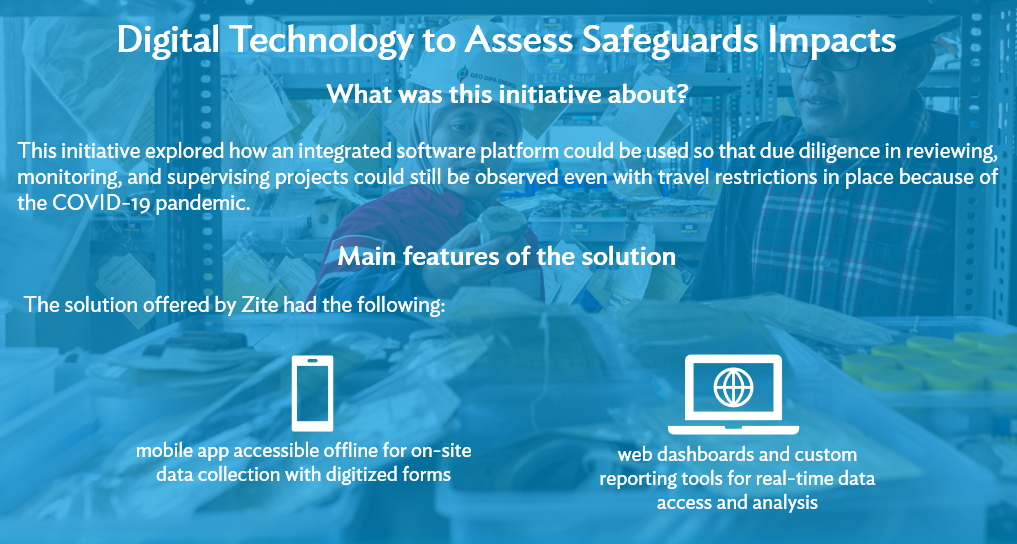Digital Technology to Assess Safeguards Impacts: Using technology for remote monitoring to observe safeguards due diligence
Start of implementation: 2021
Technology type: Web and mobile apps
Technology service provider: Zite
ITD’s Partner ADB Department: Economic Research and Development Impact Department
ADB Partners:
· State Electricity Company of Indonesia—local partner in Indonesia
· Sustainable Development Tourism Project team from the Tourism Infrastructure and Enterprise Zone Authority—local partner in the Philippines
In line with ADB’s Operational Priority:
· Tackling climate change, building climate and disaster resilience, and enhancing environmental sustainability
o Environmental sustainability enhanced
Travel restrictions and border closures during COVID-19 made conducting field visits a challenge. The inability of personnel to monitor the status of implementation of the bank’s various projects put projects at risk of delays and inaccurate assessments. The environment and the residents who rely on natural resources to support their lives and livelihoods may be endangered when projects are not properly monitored. These impacts, intentional or not, are antithetical to ADB’s goal of addressing poverty and reducing inequalities.
Proactive steps were needed to put into place measures that would allow personnel to continue monitoring projects remotely in case similar circumstances occur in the future. Therefore, it was deemed necessary to develop a digital platform to support remote monitoring and comply with the safeguards requirements. This, in turn, would ensure that potential negative impacts on communities and the environment would be addressed.
ADB ran the “Digital Technology to Assess Safeguard Impacts” challenge in 2020 to crowdsource solutions that leveraged digital technology to support the remote assessment of the potential impacts of projects on land, assets, people, and the environment. Forty-two teams participated in the challenge.
Zite was ultimately selected to test its proposed solution, an integrated software platform with mobile and web apps that can be used to remotely manage and monitor projects. The mobile app allowed personnel from different project sites to collect data relevant to safeguards impacts even while offline. The collected data was uploaded on the cloud once they go back online. Collected data was consolidated in one platform, which featured dashboards and custom reporting tools to enable experts and the management to review and analyze the data in real time. The platforms that were rolled out had various modules for data analysis. They were also capable of generating maps and reports. The reports were used to aid in making data-driven decisions relevant to safeguards issues involving the project.
The digital platform was tested in two projects.
Under the “Sustainable Energy Access in Eastern Indonesia—Electricity Grid Development Program Phase 2” project in Indonesia, the State Electricity Company of Indonesia (PLN) used Zite as a tool to digitize the inspection of warehouses that stored potentially hazardous materials. These inspections are conducted every 3–6 months. Five warehouses were initially registered in Zite. Their warehouse managers were assigned as Site Supervisors in Zite in August 2021. They were provided with training on how to use the platform, including how to fill up the digitized monitoring forms, which were available in English and Bahasa. Meanwhile, regional managers were assigned as Reviewers to monitor the submissions of the warehouses. The PLN leadership were tagged as Project Managers. Thirty more warehouses were subsequently added to Zite. Site supervisors and regional managers were provided capacity building in August 2021 following initial positive feedback.
Meanwhile, the Sustainable Development Tourism Project team from the Tourism Infrastructure and Enterprise Zone Authority (TIEZA) in the Philippines was trained on using Zite to conduct a socioeconomic survey of the individuals and households that may be affected by the “Sustainable Development Tourism” project. Zite used a subset of the results of a 2019 socioeconomic survey conducted on the project site to demonstrate how the platform could be used to re-conduct the survey to get updated data on households and individuals affected by the project. Zite was also intended to be used as a monitoring tool to mitigate its impacts. Three forms—the socio-economic survey, the inventory of losses, and the detailed measurement survey—were developed and uploaded to the platform in line with these objectives. However, the actual testing was put on hold because of implementation changes and delays.
Refinements were made by the Zite team on the platform following feedback provided by the project teams and ADB.
The initiative showed that going digital can result in:
· Faster and easier data collection. Zite made data collection faster and quicker by allowing field personnel to directly input the information on the platform from the moment of collection. This eliminated the need to use paper-based forms and manual transcription.
· Easy data sharing. The uploaded data could be viewed by managers quickly, allowing them to receive real-time updates, provide guidance to field personnel, and ensure data quality. Various stakeholders also had access to the data, which made collaboration easier.
· Easy data analysis. Zite had various modules to make it easier for users to analyze the data, create reports, and generate maps.

